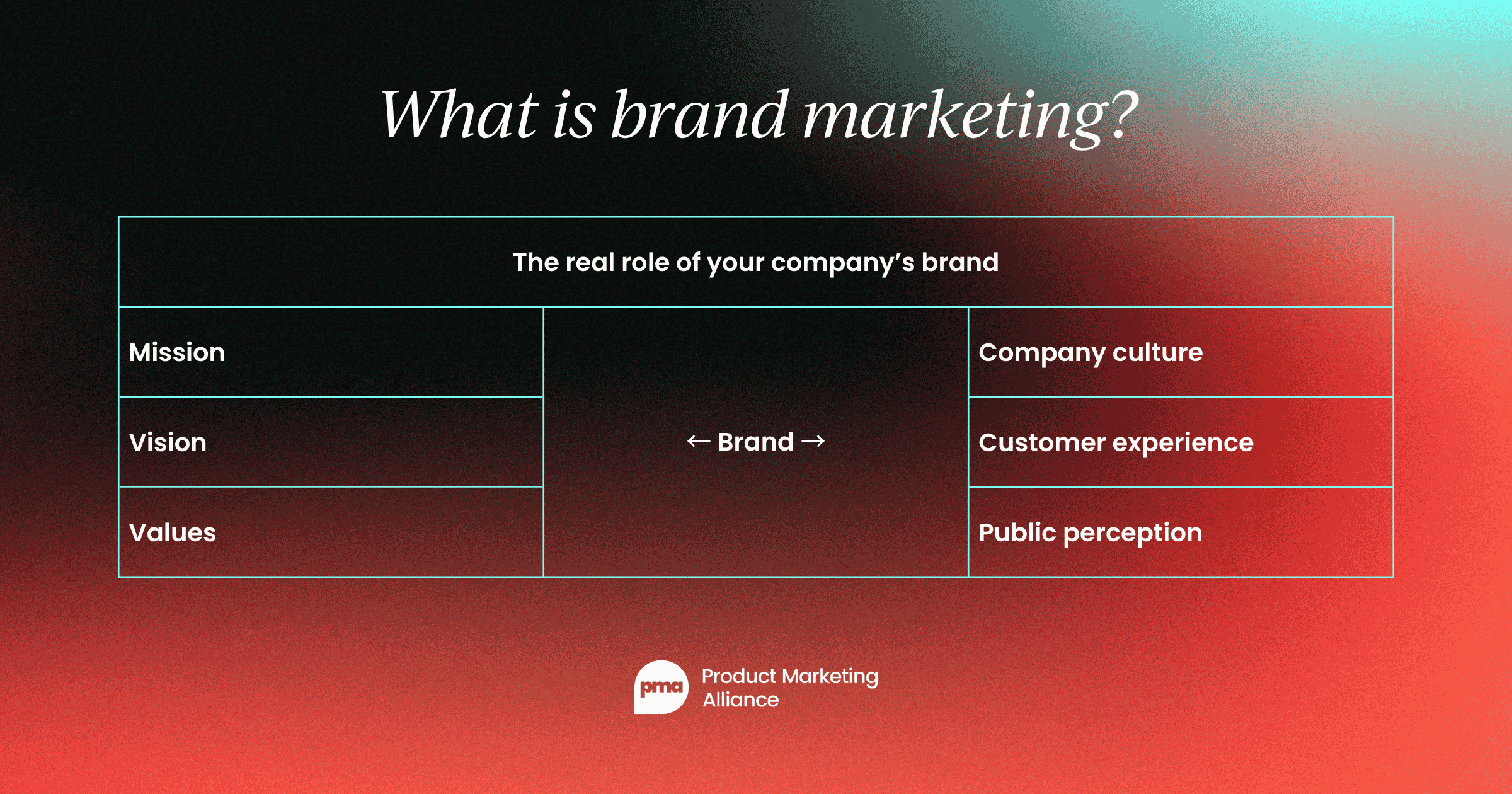Most of us enter a marketing domain – brand, product, performance – and develop deep expertise in that area. But if we want to achieve top-level career growth, we suddenly need to be experts across all facets of marketing.
If we get stuck in one lane and lack the credibility to gain buy-in or become marketing-wide thought leaders, we won’t be considered for broader marketing leadership.
Today, I’ll share some insights into how to expose yourself to brand marketing initiatives, such as how to consider your brand in your product launches.
You’ll see how interconnected these functions are, and start to understand how to capture and support more holistic success across your marketing organization.
What is brand marketing?
In 2019, I was attending Denver Startup Week (Now Colorado Startup Week). I had been leading product marketing for a B2B Healthtech startup, but I wanted to level up the function and expand the team.
One talk featured fellow PMAers Kristen Ditsch and Megan Sullivan-Jenks talking about brand vs. product marketing. They called product marketing “the head” and brand marketing “the heart”.
These two worked closely together and knew how to make marketing stronger by working together. They kick-started my awareness of how important and interconnected this partnership is. So let’s dive in!
Brand marketing is the story of why your organization exists, and how it delivers a meaningful, emotional connection to your audience.
One caveat here – brand marketing is not the same as the brand. When you think of a brand, you might recall a logo or a tagline. Brand marketing is the strategy that communicates your company’s identity to your audience.
Brand marketing can be measured by awareness, loyalty, credibility, positioning, and preference. And it goes beyond an ICP or customer. There might be brands you love that you’ve never even purchased from!
Brand is the red thread, the throughline that supports your company as it evolves. It’s as unique as a fingerprint and is the least measurable marketing pillar. It’s frequently underinvested in, and almost impossible to catch up if leadership has underinvested.

You can tell which companies decide to invest in their brand identity, and which don’t. When you have a positive emotional connection to a brand or company, they likely invested in their brand early and thoughtfully.
Your company’s brand investment sets up the foundation for product marketing across positioning, the customer journey, experience, and differentiation.
Your brand strategy establishes your right to win with a unique point of view. It clarifies what attracts people to your category and defines the emotional benefits to your buyers to justify things like premium pricing. Ultimately, it’s how your entire organization delivers on its commitment to your customers.
Mission, vision, and values are usually owned by executive leadership, so brand strategy becomes a way to connect marketing internally across the organization as well.
Brand marketing is made up of strategies around identity, distribution, and governance. Your ability to connect your launches, packaging, pricing, and other deliverables into this flywheel can amplify your team’s ability to acquire, retain, and monetize across your customer base.
What is product marketing?
It seems silly to answer this here, but product marketing is the process of bringing a product or feature to market. PMMs are the user champions, plus they serve as the translation layer between the teams who build the product and those who service the product.
The roles across PMM can vary widely. You may only be responsible for launch tasks. Or you may own a fully integrated go-to-market (GTM) strategy.
Regardless of your scope, there are opportunities for you to develop your brand marketing expertise.
Executing on a cross-domain strategy
Marketing is interdependent. Whenever there are changes to your company strategy, such as a shift in category or entering a new market, you can expect changes to user behavior. When this happens, you may see a shift in the resource allocation across marketing.
The right mix of investment across brand, product, and growth marketing shifts according to a company’s stage, goals, and external marketing factors. For example, entering a new market requires awareness.
Leadership may initially prioritize investments in brand marketing over product or growth marketing until the market recognizes your company’s offerings.
Take a moment and assess:
- What stage is your company in (established, high growth, etc)?
- What are your company’s growth goals? Are you on target?
- What are the marketing initiatives that are contributing to those goals?
- How well do you and the go-to-market function understand the audience that is helping your company achieve its goals?
As you ponder, you might notice some potential problems. Do you have an awareness problem, as in not enough people know about what you offer? Does your messaging resonate, or do you see limited conversion or engagement? Can you clearly define how and why you’re different in the market?
From what you now know about the brand, you see that your team and the brand team likely have similar objectives. If you can align on the approach, you can lean on the brand team’s expertise across distribution channels to address growth inhibitors or headwinds.
Let’s look at some scenarios:
Scenario 1
You’ve crafted new messaging and tested it as an anonymous company on a messaging test site. The feedback was generally positive, but since you’ve implemented it on your website, you’ve noticed page performance waning.
Aligning brand and product marketing: You decide to reference your brand guidelines, which include things like tone and voice. You realize that while the messaging is good, it doesn’t really sound like the rest of the copy on your website.
Customers are encountering an inconsistent user experience, which lessens their engagement.
Next time: Build your messaging on top of brand guidelines. Ask someone on the brand team, such as a copy editor, to take a peek and give you feedback on how to make your messaging sound more aligned with your brand.
It’s especially important if you launch messaging across multiple channels. Double-check, and make sure your assets are aligned with your brand governance across all channels.
Scenario 2
It’s launch day! And this feature is amazing. You and your product team are so excited to bring this to market. You’ve developed launch activities and have aggressive goals. But two months post-launch, you’re really struggling to gain adoption.
Aligning brand and product marketing: You set up some time with a few customers. They think it’s cool, but they don’t really know why they should use it. Or maybe they understand it could save them time, but it’s a bit confusing to navigate implementation and pricing.
You realize you didn’t connect the why to your launch materials and the implementation experience. You’re missing an emotional connection with your audience.
Next time: Consider your company’s brand strategy – why does your company exist and how does it deliver an emotional connection to your buyers? Build your GTM plan around the brand identity and expected customer experience to create an adoption plan that fits seamlessly with what your customers know and love.
Scenario 3
You’ve been tasked with a new enterprise initiative – your company is going upmarket and you’re the one they trust to lead the charge.
The product is ready, and you’ve worked on a new package with a unique name and sales motion specifically for this enterprise audience. It’s not going well. You and the sales team are struggling to gain traction and build pipeline.
Aligning brand and product marketing: Your brand should be familiar to this audience, but with this new, specially-named package, buyers aren’t connecting this offering back to your brand. You’re trying to build a new sales motion without trust, brand equity, and relevance.
Next time: Avoid over-segmenting your marketing. Keep a clear connection to your brand identity. You can make it unique and compelling while also maintaining your emotional connection to the buyers through the brand drivers of awareness and credibility.
Building your career
Marketing teams can’t execute their strategy without the resources and inputs from across brand, product, and growth marketing. When the company reaches an inflection point, like a change in strategy, you’ll need to work cross-functionally to understand how you continue to create value in the market.
You can lean on the foundational investments from your brand team to clearly communicate how you solve your customers’ problems. Start to think like a team, partner with your brand counterparts, and build breadth into your marketing expertise.
Aligned teams create successful launches and gains in revenue. After all, none of us would be here without both “the head” and “the heart”.




